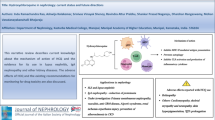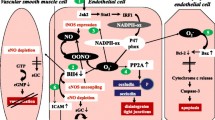Abstract
The effects of vitamin E on tissue oxidation, kidney function and morphology were studied in rats with nephrotoxic nephritis (NTN). Thirty-six nephritic animals received no treatment (group 1), while 36 were treated with vitamin E (group 2). Twenty-four hours after the administration of anti-glomerular basement membrane antibody, sulfhydryl-containing renal protein was significantly lower in group 1 than in group 2 (0.70±0.16 and 1.08±0.06 mmol/100 g kidney tissue, respectively), suggesting a free oxygen radical scavenging effect of vitamin E in group 2. The difference was similar on day 14. The creatinine clearance was significantly lower in group 1 than in group 2 on day 1 (40±30 and 204±60 μl/min per 100 g body weight, respectively). The protein excretion was initially high in both groups, but a significant decrease was detected in group 2 relative to group 1 on day 14 (25±18 and 92±38 mg/24 h, respectively). The morphological changes were less severe in group 2. Vitamin E treatment did not alter any of the above values significantly in healthy animals. The release of oxygen free radicals in NTN might play an important role in the pathogenesis, which can be influenced by free radical scavengers through changes in kidney function and morphology.
Similar content being viewed by others
References
Couser WG, Baker PJ, Adler S (1985) Complement and the direct mediation of immune glomerular injury: a new perspective. Kidney Int 28:879–890
Thomson NM, Holdsworth SR, Glasgow EF, Atkins RC (1979) The macrophage in the development of experimental crescentic glomerulonephritis. Am J Pathol 94:223–235
Fantone JC, Ward PA (1982) Role of oxygen derived free radicals and metabolites in leukocyte dependent inflammatory reactions. Am J Pathol 107:395–418
Roos D, Weenig RS, Voetman AA (1980) Protection of human neutrophils against oxidation damage. Agents Actions 10:528–535
Sacks T, Moldow CF, Craddock PR, Bowers JK, Jacob HS (1978) Oxygen radical mediated endothelial cell damage by complement stimulated granulocytes: an in vitro model of immune vascular damage. J Clin Invest 61:1161–1167
McCormick JR, Harkin MM, Johnson KJ, Ward PA (1981) Suppression by superoxide dismutase of immune-complex-induced pulmonary alveolitis and dermal inflammation. Am J Pathol 102:55–61
Petrone WF, English DK, Wong K, McCord JM (1980) Free radicals and inflammation: the superoxide-dependent activation of a neutrophil chemotactic factor in plasma. Proc Natl Acad Sci USA 77:1159–1163
Weis SJ (1979) Neutrophil generated hydroxyl radicals destroy RBC targets (abstract). Clin Res 27:466 A
Rehan A, Johnson KJ, Wiggins RC, Kunkel RG, Ward PA (1984) Evidence for the role of oxygen radicals in acute nephrotoxic nephritis. Lab Invest 51:396–403
Rehan A, Wiggins RC, Kunkel RG, Till GD, Johnson KJ (1986) Glomerular injury and proteinuria in rats after intrarenal injection of cobra venom factor. Evidence for the role of neutrophil-derived oxygen free radicals. Am J Pathol 123:57–66
Boyce NW, Holdsworth SR (1987) Intrarenal hemodynamic alterations induced by anti-GBM antibody. Kidney Int 31:8–14
Boyce NW, Holdsworth SR (1986) Hydroxyl radical mediation of immune renal injury by desferrioxamine. Kidney Int 30:813–817
Meister A (1983) Selective modification of glutathione metabolism. Science 220:472–447
Flohe L, Gunzler WA, Ladenstein R (1976) Glutathione peroxidase. In: Arias IM, Jakoby WB (eds) Glutathione: metabolism and function. Raven, New York, pp 115–135
Hornsby PJ, Pearson DW, Autor AP, Aldern KA, Harris SE (1985) Selenium deficiency in cultured adrenocortical cells: restoration of glutathione peroxidase and resistance to hydroperoxides on addition of selenium. J Cell Physiol 123:33–38
Meister A, Anderson ME (1983) Glutathione. Annu Rev Biochem 52:711–760
Malloy MH, Rassin DK (1984) Cysteine supplementation of total parenteral nutrition: the effect in beagle pups. Pediatr Res 18:747–751
Deneke SM, Gerschoff SN, Fanburg BL (1983) Potentiation of oxygen toxicity in rats by dietary protein or amino acid deficiency. J Appl Physiol 54:147–151
Pascoe GA, Reed DJ (1989) Cell calcium, vitamin E, and the thiol redox system in cytotoxicity. Free Radic Biol Med 6:209–224
Wefers R, Sies H (1988) The protection by ascorbate and glutathione against microsomal lipid peroxidation is dependent on vitamin E. Eur J Biochem 174:353–357
Shan X, Aw TY, Jones DP (1990) Glutathione-dependent protection against oxidative injury. Pharmacol Ther 47:61–71
Portis JL, Wikel SK, Mcatee FJ (1979) A simplified rapid method for purification of glomeruli. J Clin Pathol 32:406–409
Sedlak J, Lindsay RH (1968) Estimation of total, protein-bound and nonprotein sulfhydryl groups in tissue with Ellman's reagent. Anal Biochem 25:192–205
Bertani T, Livio M, Macconi D, Morigi M, Bisongo G, Patrono C, Remuzzi G (1987) Platelet activating factor (PAF) as a mediator of injury in nephrotoxic nephritis. Kidney Int 31:1248–1256
Oldham KT, Guice KS, Ward PA, Johnson KJ (1988) The role of oxygen radicals in immune complex injury. Free Radic Biol Med 4:387–397
Buege JA, Aust SD (1978) Microsomal lipid peroxidation. Methods Enzymol 52:308–310
Recknagel R, Glende EA (1984) Spectrophotometric detection of lipid conjugated dienes. Methods Enzymol 105:331–337
Deneke SM, Fanburg BL (1989) Regulation of cellular glutathione. Am J Physiol 257:L163-L173
Webb JL (ed) (1966) Enzyme and metabolic inhibitors. Academic Press, New York, vol II, pp 635–653, 729–985; vol III, pp 1–283, 337–365, 595–793, 795–819
Freeman BA, Crapo JD (1982) Biology of disease: free radicals and tissue injury. Lab Invest 47:412–426
Author information
Authors and Affiliations
Rights and permissions
About this article
Cite this article
Endreffy, E., Túri, S., Lászik, Z. et al. The effects of vitamin E on tissue oxidation in nephrotoxic (anti-glomerular basement membrane) nephritis. Pediatr Nephrol 5, 312–317 (1991). https://doi.org/10.1007/BF00867490
Received:
Revised:
Accepted:
Issue Date:
DOI: https://doi.org/10.1007/BF00867490




